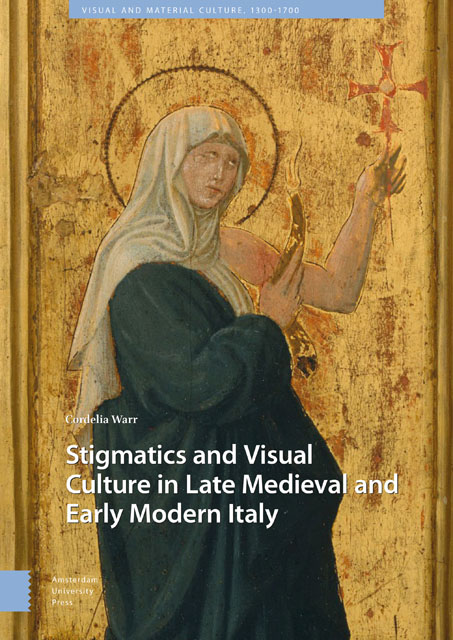Book contents
- Frontmatter
- Table of Contents
- Acknowledgements
- List of Illustrations
- 1 Introduction: Stigmata and Visual Culture
- 2 Saint Francis of Assisi as Image
- 3 Representing the Invisible: Saint Catherine of Siena’s Stigmatization
- 4 The Stigmatic Spectrum and the Visual Arts
- 5 Gregorio Lombardelli, Invisibility, and the Representation of Saint Catherine of Siena’s Stigmata
- 6 Performing Stigmata
- 7 Painting, Printing, Sculpting, Forgery (and Washing)
- 8 Conclusion: The Timidity of the Visual Arts
- Complete Bibliography
- Index
2 - Saint Francis of Assisi as Image
Published online by Cambridge University Press: 06 December 2022
- Frontmatter
- Table of Contents
- Acknowledgements
- List of Illustrations
- 1 Introduction: Stigmata and Visual Culture
- 2 Saint Francis of Assisi as Image
- 3 Representing the Invisible: Saint Catherine of Siena’s Stigmatization
- 4 The Stigmatic Spectrum and the Visual Arts
- 5 Gregorio Lombardelli, Invisibility, and the Representation of Saint Catherine of Siena’s Stigmata
- 6 Performing Stigmata
- 7 Painting, Printing, Sculpting, Forgery (and Washing)
- 8 Conclusion: The Timidity of the Visual Arts
- Complete Bibliography
- Index
Summary
Abstract
Lauded as unique by Franciscan writers, the stigmata defined Francis as part of a narrative event and as an attribute. They were also extremely disquieting, making Francis both another Christ and an image of Christ. The insistence that the stigmata were miraculous and unprecedented provoked angry reactions. Some responses were focused on images, considered particularly problematic because of the perceived link between truth and representation. In this chapter, I investigate three miracle stories from the thirteenth and fourteenth centuries that focus on the depiction of stigmata in paintings of Saint Francis. They provide insights into the expectations that people had of images and of picturing the miraculous, allowing us to question the responses to the visual representation of stigmata.
Keywords: stigmata, miracles, painting, wounds, bleeding, alter Christus
This chapter focuses on three miracle stories from the thirteenth and fourteenth centuries that deal with the depiction of stigmata on painted images of Saint Francis of Assisi (d. 1226). The paintings in the narratives both depicted the miraculous and were themselves miraculous or conduits for the miraculous. It is possible that the specific images to which the sources referred never existed except as written constructs designed to make a particular point about Francis's miraculous stigmata. Nonetheless, the stories allow an interrogation of the, sometimes visceral, responses to the visual representation of stigmata and, in doing so, provide insights into the expectations that people had of the tasks of art and, in particular, of picturing the miraculous.
In the Legenda Maior (Major Legend), the official life of Francis written by Saint Bonaventure (1221–1274) and presented to the general chapter of the Franciscan Order at Pisa in 1263, the stigmatization was described as having taken place on the feast of the Exaltation of the Holy Cross (14 September) in 1224. While fasting and praying on Mount La Verna, Francis received a vision of a seraph and, after the vision disappeared, nail-like protuberances appeared in his hands and feet and a red wound on his right side. During the remaining two years of his life, he kept the stigmata a close secret. Only those nearest to him knew of them or had the opportunity to see them.
- Type
- Chapter
- Information
- Publisher: Amsterdam University PressPrint publication year: 2022

